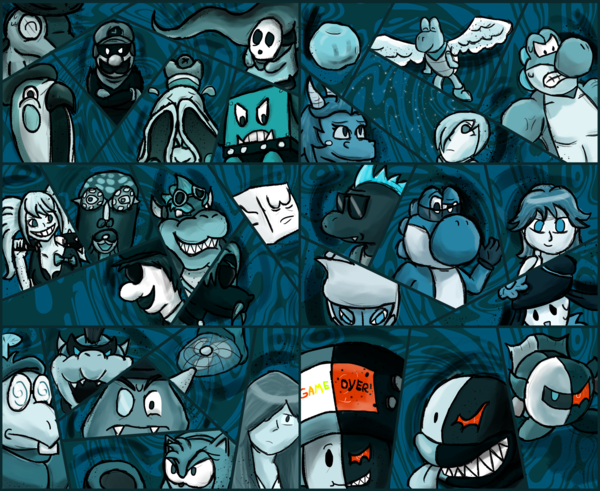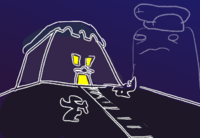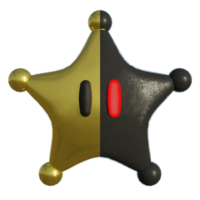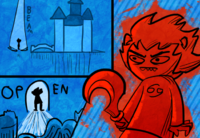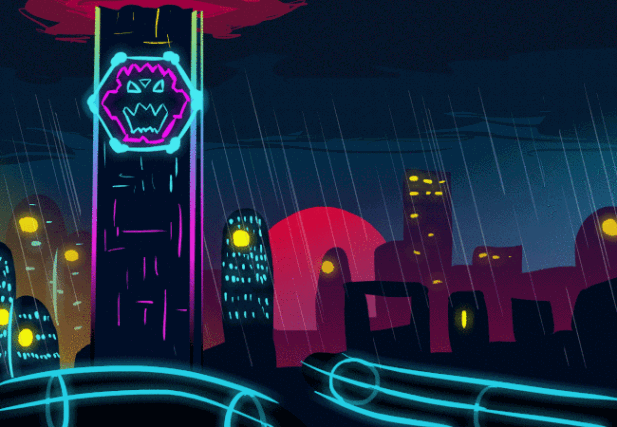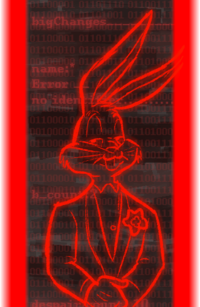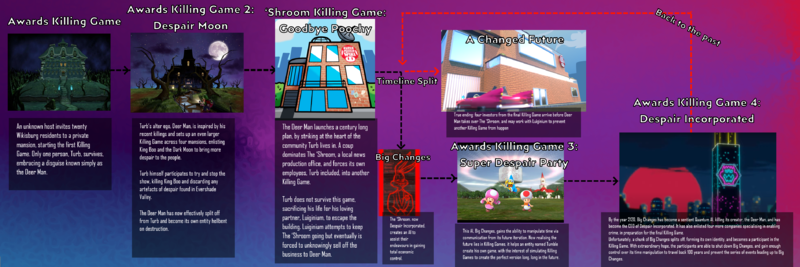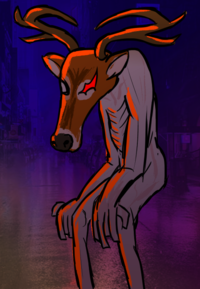The 'Shroom:Issue 165/Killing The Killing Game
Greetings, festive friends. Today is the day prophecy is defied - for 3 years, users have been tiptoeing from 'Shroom issue to 'Shroom issue, sneakily avoiding bringing up the phenomenon that has infected the minds of many members of this newspaper. This infection? It's the Killing Game, of course! Originally conceived as a forum activity for online communities, it has blossomed into a niche party game that has run annually since 2017.
Today I'm here to wrap everything up in a neat bow and convey my thoughts on the last few games as both a player and a host. I've been an active participant in all five games, as either a player or host. Does this give me the authority to publish judgement on such a high-effort work? Yyyyeah. It's fine. The only tradition as strong as hosting a Killing Game in the summer is forgetting to write about the event in The 'Shroom. It happened once in 2017, and then never again. Well, now I'm going to do everyone's jobs for them and write retrospectives for the last 3 years of Killing Games. You're welcome.
Anyway, it's time to Kill off the Killing Game. Let's begin.
How to play
Whenever someone tries to introduce the gameplay mechanics of the Killing Game, they always end up defining it as a combination of video games and Dungeons and Dragons. For example, think Danganronpa meets Town of Salem meets... Dungeons and Dragons. Oh, I could probably now throw Among Us into the mix as well. That person then has to desperately follow up with "wait, no, it's still fun!" after bringing up a bunch of infamous nerd culture icons.
The objective is simple: Kill or be killed. This objective is realised through two repeating phases, where players 'submit' a list of intended actions to a host, who facilitates the gameplay like a Dungeon Master;
- The Night Phase - where players first work alone to gather resources, explore their surroundings, and may attempt to secretly kill another player.
- The Day Phase - where the surviving players work together to investigate the death, determine the killer through witness testimony and analysis, and then eliminate the guilty party via a democratic lynch.
So, the objective is a little more difficult. Kill someone, and you have to have a plan airtight enough to avoid being caught by even the most ace detectives. Avoid suspicion, and you get a reward, but if they figure you out, you are lynched without mercy. Justice is no longer your friend. Avoid killing people, and you risk not becoming powerful enough to fend off attackers later in the game, and you miss out on a critical part of the game. It's the killer's job to trick everybody, through obscuring evidence, lying in your testimony, and attempting to convince your fellow players to lynch somebody else.
Gameplay is incredibly freeform - you can do whatever you want, as there are no restrictions thanks to each game having a personal host. This enables creative cases, memorable interactions, and hidden secrets to be discovered without any prodding from the game hosts.
This is as simple as it gets. Throughout the years, the gameplay has evolved to freshen things up and provide more opportunities for interesting murder mysteries. A map was implemented very early on, giving players a world to explore and resources to find. Players received unique roles, giving them talents that only they could use. These roles were later given stats and forbidden actions, to balance players out and give them restrictions to work with. NPCs were host-controlled characters that could provide extra information or services to players.
The game is much easier to understand once you see it in action. If you're interested, I would encourage browsing through old forum threads dedicated to the events. You can find links to the games under the relevant headings below.
Genesis
In the beginning, there was Minus World, a sister forum where all the older nerds hung out and played games without being attached to the Mario name. The forum itself is one giant game, with EXP and spells you can cast on other people's posts, and so on. On January 23rd, 2017, user Fun With Despair created the first thread for the first Killing Game. From there, there ended up being about two and a half games throughout the first half of the year, until player and participant Lord Bowser decided to adapt the format and bring it over to this community, to introduce a fresh new game to the masses. Every summer, we all celebrate the anniversary of this wiki by hosting games and activities, competitions, and so forth. The lineup was getting a little cold, and with the previous 'landmark' game, Mafia, on its way out, there couldn't have been a better time to bring in the new Killing Game.
Awards Killing Game 1: Despair Mansion
Hosted by: Lord Bowser
Date: Summer 2017
Lounge | Game Thread | Class Trial (voting)
The first game to be carried over to this particular community, created in the summer of 2017 to celebrate that year's annual Mario Awards. With the shift in forum came a dedication to the Mario franchise - the game was now set in Luigi's Mansion, with each room in the massive building serving its own purpose. Without much of a story beyond "it's a killing game, go nuts", the players were free to develop their own creative potential. One interesting mechanic that didn't show up again was the use of 'day actions', a passive way to set things up without risking being seen by others. This was used primarily to arrange parties and group events, and to my knowledge was thankfully not abused (say, to set up a trap in a room without being caught).
I was one of the handful of players who hadn't played a Killing Game before, and so I had to figure out the game as I was playing. This led to more and more elaborate night actions, from going to one room and sleeping on the first night, to making detailed elimination attempts, building tools, and attending socials by the end. As my knowledge and experience with the game grew, so did my enjoyment. I even managed to make it to the final phase of the game, though my lack of planning ahead left me in an understated third place. Now that I've established that I'm not at all sore about this, let's start criticising the game!
Now, of course the first game of its kind doesn't come without some shaky design. In the day phase, players had access to a variety of tools that put the killer at a very bad disadvantage. This included the ability to 'sweep' the mansion for an item, essentially being able to locate any hidden object. All objects could also be checked for fingerprints, meaning that 'hiding the weapon' is no longer a viable strategy at all, given that you could be found guilty in two short investigations. Now, this did lead to other creative methods of murders - including the famous Crown Kill, wherein user Shokora wore a princess costume to a party, and proceeded to stab someone in the chest with a crown. There's no need to hide the murder weapon when no one can figure out what it is!
All of this can be forgiven when the genre was still finding its footing, and I'm pleased to report our gracious host Lord Bowser contributed to the official sequel game. You'll find below that the quality of that event is certainly enough to outweigh any errors in this one. Good job, LB!
The 'Shroom Killing Game: Goodbye Poochy
Hosted by: GBAToad, Meta Knight
Date: Winter 2017/2018
Lounge | Game Thread | Class Trial (voting)
Three years ago, the 'Shroom writers were busy finishing off another holiday special, when a mysterious benefactor hires a murderous bear to knock everybody out and bolt all the doors and windows shut. Someone wants the 'Shroom shut down, and they're willing to kill dozens of people to see it through. Can the employees survive long enough to put a stop to this plan?
Considered by some to be the Melee of KGs (in this community), this game made many big changes and large leaps in design and gameplay, making it the first 'spectacle' game so far. Roles were presented as a flashy slideshow of images, and the map was an original design, drawn by the hosts. In fact, this game had an interactive program that allowed you to view the map and room descriptions in a fun little widget! Each role came with 8 stats, reflecting various facets of interacting with the game - survival instinct, strength, speed, sleuthing, and so on. In order to make the map more exciting, some rooms were locked at the start of the game, with keys being distributed as players progressed through.My personal experience? I died on the second day, after being rightfully convicted for the onion-based murder of eternal rival Ninelevendo. I still had a lot of fun, however, and followed the game to the end as a spectator. This game is particularly iconic to me, as I had a lot of ideas carried over from my first game, and the design of the map felt a lot more open in ways I can't explain. Every murder case in this game was brilliant and creative, from using plungers to ascend the back of the building to disguising as your ally and wreaking havoc on camera. Or, uh, throwing an onion at someone so they fall out of a window and land on a pile of swords. Genius.
The previously mentioned spectacle culminated in a brilliant final night. The last game had set the trend; endgames are brutal. The final four had plans upon plans, and resulted in a dramatic piece of writing with a surprise ending that ties up something not yet seen before - a plot. Whereas previously, the game would just end once one player remained, this time a true objective was written into the finale. While there could only be one winner, the note the story ended on was one of hope, rather than death.
Awards Killing Game 2: Despair Moon
Hosted by: GBAToad, Superchao, Smasher, Lord Bowser
Date: Summer 2018
Smash Bros comparison: 4 (for Wii U and Nintendo 3DS)
Lounge | Game (Gloomy Manor) | Game (Old Clockworks) | Game (Haunted Towers) | Game (Treacherous Mansion) | Class Trial (voting)
It's back. Thirty New Wikisburg residents find themselves trapped in Evershade Valley, forced to kill each other to satisfy the whims of King Boo and his undead friends.
This game is most notable for cementing a number of staple mechanics to the series. With an enormous player count of thirty, it was no longer viable to have the game play out in one location. So came multiple maps! In the first half of the game, the players were divided in half and distributed across two separate maps. Once roughly half the players had been eliminated, the survivors were grouped back together and placed in a brand new map for the second half of the game, whilst the dead players were given a second chance at life in a ghost-only map, with the reward of joining the other survivors if they won.
What better setting to accommodate this new mechanic than Evershade Valley, the eerie landscape home to five distinct mansions? And so the Gloomy Manor, Haunted Towers, Old Clockworks, Secret Mine and Treacherous Mansion all saw use in this game, with E-Gates linking the five buildings together for exploration and discovery purposes. It doesn't make much sense to have all this hard work permanently locked off halfway through the game, right?This game also sported a refined stats system, trimming it down to five variables; strength, speed, social, stealth, and stamina. By removing the more questionable ones from last time, roles were more about what you CAN do rather than working around restrictions set by, say, a low 'survivability' stat. But for all these mechanical features, the same stupid goofing around still happened, of course. Players embraced the new rigid ruleset with vigour and whimsy, and of course created a whole new set of memorable cases, players, and events. The story beats allowed for quality roleplays and interactions between the player and game, and it's one of my favourite parts of the games as a whole.
Now to talk about the real big change. This time, there could be more than one winner. Taking a page from Danganronpa, as the stories became more involved it made sense to create endings that didn't force the winner to kill their remaining allies. Thus, five lucky players were given the opportunity to leave the eternal conflict for good. By solving five puzzles placed in each map, a player was awarded with a shard of the Dark Moon, which was key to exiting Evershade valley. A normal player would have to ally with four others, as no mere mortal could handle the power of five shards alone. Except me. I had a role for that.
While my time spent with it was short, AKG2 remains one of my favourite events in the community, and one that felt incredibly polished down to every detail. A sincere thumbs up to the four of you.
Awards Killing Game 3: Super Despair Party
Hosted by: Roserade, Hooded Pitohui, Lakituthequick
Date: Summer 2019
Smash Bros comparison: Brawl
Lounge | Game (Peach's Castle) | Game (Bowser's Castle) | Game (Eternal Star) | Class Trial (voting)
Something that always gets brought up when AKG3 is discussed is the alleged imbalance of the role list. An admittedly hilarious example is a role inspired by the indie game Baba is You, which inadvertently allowed its user to become nearly omnipotent. Or maybe you've heard of the role that kills its user if they refer to themselves in the first person? While these two roles can't avoid fair critique, I think the game as a whole was much more balanced than the reputation makes it out to be. With thoughtfully crafted roles for beginners, to clever roles that allowed for manipulation without it being unfair, this game had a damn good lineup.
This is another (my third) game where I died early, but I still followed along with the game through to its end. I can surely say that this game was yet another thrill to be a part of, and the three hosts did a commendable job, especially considering how new most of them were to hosting.
Awards Killing Game 4: Despair Incorporated
Hosted by: GBAToad, The Pyro Guy
Date: Summer 2020
Smash Bros comparison: Ultimate ('independently' verified)
Lounge | Game (Archangel Solutions) | Game (Deimos Matrix Corp) | Game (Neo Hope Foundation) | Class Trial (voting)
100 years in the future, the forces of Despair have won and established a corporate monopoly within Neo Bowser City's economy. 26 disgruntled employees trapped in the Neo Bowser Skyscraper must do the bidding of their CEOs, led by a strange quantum AI designed to propagate Despair far into the future. You can't stop this timeline, but you can prevent it from ever happening in the first place.
In some ways, this game was a basic continuation of the formula established in the previous games. The maps were different floors in a skyscraper - two starting maps, and a merge. With the Biblical galleries of Archangel Solutions, and the Neo-capitalist haven of Deimos Matrix Corp, followed by the labyrinthine complex of the Neo Hope Foundation, each section of the building had its own theme, its own backstory, and its own secrets. Keys make a return, too, and ghosts are given the chance to appear for one night. This should all be familiar by now!The innovations this game makes are all centred around the underlying theme of The Economy. Introducing NPCs: host-controlled characters that lead dangerous industries. Gain their favour, and they may team up with you and provide exclusive services. How do you win their favour? Shares. This game contained a stock market that players could use in the daytime, to exchange their own stocks with shares in the four available companies. Active and correct participation in the day phase gave your trades more weight, which is essential in a viciously competitive market. After all, there's 25 other traders wanting a piece of that pie. If you own the most shares in a company, the NPC in charge will be obligated to carry out tasks for you.
While the NPCs were initially established as sinister fellows with a penchant for suffering, they quickly grew and moulded into beloved characters that eventually decided to side with the players and oppose their boss in the name of hope. This game was certainly story-driven, and with four mouthpieces in our control, we could craft a narrative that adapted along with the players' intentions for the story. And not forgetting Big Changes, the sentient AI monolith behind it all, and the story link that connects all five Killing Games. All of this culminates in a CGI cinematic, a true ending and proper-send off to the series as a whole.
My personal thoughts on this game are complex, although hugely positive, and me and GBA are extremely grateful for all of the praise and feedback we've received on this endeavour. I don't want to talk too much about the moment-to-moment process of building this game up, because this game wouldn't have been nearly as fantastic as it was without the everlasting work of GBAToad. If you take anything away from this article, it's that he built this monster. With three of the five games crediting him as host, you simply have to commend the end result of his efforts spanning the last 3 years.
The Deer Man, and the quirks of storytelling
Just as every Killing Game iterates on its predecessor, every game will also try and connect itself to the ongoing storyline each game contributes to. This story... is the tragic tale of the Deer Man. Buckle up, I made a timeline for this.
The Deer Man was the in-game alter-ego of user Turboo, winner of AKG1 and AKG2. First born perhaps out of a desire for chaos without the accountability, this character quickly became an enigma, then a villain. From here, The Deer Man was present (sometimes retroactively) in every game following, finding some way to take credit for the despair and ruin brought forth every year. After seeing off the deaths of over fourty peers in Despair Mansion and Evershade Valley, The Deer Man sought to strike the heart of the community it spawned from, and targeted the local press. Posing as a senior staff member, it locked the writing team within the walls of their headquarters and coerced them into killing each other. With one left, The Deer Man attempted to take down the survivor himself, but was defeated, and swears to return once The 'Shroom naturally declines and stage a coup.
In time, the gambit was a success, and The 'Shroom was taken over and transformed into Despair Incorporated. The Deer Man started to think about his lifespan, his legacy, and felt a great desire to maintain control for centuries forth. This led to the creation of Big Changes, a digital mind with the sole purpose of analysing the stock market and ensuring Despair Incorporated has a complete economic monopoly until the end of time. And, like any story about AI, the lack of safety restrictions led to Changes developing an intelligence explosion, developing rudimentary time travel capabilities, and murdering its creator by distributing its body across several timelines. Big Changes realised the future lies in Killing Games, and worked with Tumble and other unseen benefactors to supervise 'test runs' of the Ultimate Killing Game, to commence in the year 2120.What the AI couldn't predict, however, is a piece of itself breaking free and opposing its will. This rogue piece of code found faith, and a body, and more importantly, found free will. The unsung hero worked closely with the employees of the 'Shroom Headquarters, now the Neo Bowser Skyscraper, and found a team capable of stopping Big Changes. With enough luck and spirit, they succeeded, turning Changes' time travel technology against him and returned to the past, vowing to prevent any of this despair from ever happening again. So, in one timeline, the story ends with The Deer Man slaughtered by the murders he coveted, and his legacy corrupted into a tool for good. In another timeline, the story ends with a question mark, but a promise of redemption and a stand against despair.
I'd like to also mention how much this story was improvised. It's the result of what, 10 people? We didn't work together on this, just one team coming in after the next and seeing what they could bring to the table. I wonder just how different things would be today if one player hadn't decided it would be funny to pretend to be a deer while committing crimes.
The review
Despite how uh, exciting I make this all out to be, that isn't to imply the games have their fair share of valid criticism. We've come to a point where people just don't want to hear about this damn game any more, no matter how many cinematic videos are thrown at them. After talking it through with a couple of people familiar with the games, I present the four regions of critique:
- I'm not comfortable with a game about solving murder mysteries
- Games with permanent, semi-random deaths aren't fun
- I like the format, but would rather see it put to use in a more 'adventure'-like scenario
- It takes too long to play out, and loses engagement fast
It's important to consider what aspects of a Killing Game can be changed before it stops being a 'Killing Game'. Alter the formula enough, and are you just looking at a smaller version of Dungeons and Dragons? While I understand not being able to enjoy a game purely about death, I think at the very least there should be crime involved. Without crime, there's no need to keep secrets. With no secrets, there's no mystery. I am certain that crime and punishment is integral to this formula, but concede that the crimes don't have to be murders, and the punishments don't have to be permanent lynches.
The second point is one that most resonates with me. Despite the freeform aspect of the game, when a player dies, it's sometimes hard to pinpoint what they could have done to prevent it. This is present in situations such as being in the wrong place at the wrong time in the night, or being framed and having no idea where to begin clearing their name. And when this happens, the player doesn't feel like they did anything wrong, yet still died, which is frustrating. Playing overly cautious and defensive isn't as fun as interacting with people and exploring the map! To this effect I would love to see a way for players to be able to respond to threats or attempts on their life, so I don't have to tell someone "you were just the first person to trigger this unavoidable trap, sorry".
I think the best way to resolve the third point would be, as the later games have done, to introduce additional objectives beyond the simple kill/be killed loop. A market to trade in, or a hidden treasure to locate, or a show to put on. That way, players can pursue interesting paths without having to engage with the killing mechanic. Personally, I think the last few games have proven that the format is an adventure in of itself.
The fourth point is almost certainly unsolvable, unless the medium moves away from a forum. Making cases is hard. Putting together sheets of timelines and results is hard, and its a miracle they can happen in 24 hours. Having images, videos, and prose means that each contribution made to the game is an effort, and anyone involved has to be in for the long haul. Unless, say, the whole event can happen in one afternoon using VRChat, or if some idiot funds plane tickets to a community meetup, then any Killing Game is going to take weeks, if not months. It's a vicious loop, really - the longer you take on a project like this, the more expectation there is to make the wait 'worth it'. This leads to you putting more effort into the project, which only extends delays and exacerbates the 'patience crisis'.
Conclusion, and what comes next
Well, I think everyone's pretty much done with the arc that took us this far. The book's closed on the Deer Man, and he should rest in peace after all this time. In fact, I'm surprised it's lasted this long! It's not like Danganronpa, the franchise that inspired this event, is relevant today. The legacy these games left is one that is wholly inscrutable to any outsider and divisive to any insider. I'd best compare playing and hosting to riding a mechanical bull - the thrill is amazing, and the spectacle is irreplaceable, but when it's over you're either a survivor, or you're trying to figure out how you got hurt so badly. Either way, everyone else is giving you funny looks for getting involved.Not that I want the games to stop, though. I think with the air clear, the time is right for a new chapter to begin, with real changes to the mechanics and gameplay. I think the time should be taken to look at the stagnant dissent seen whenever these games are brought up, and maybe shake things up to address them. Whether that's a set of fresh hosts, or a soft reboot, or something that isn't even a Killing Game any more, I'd like to see what happens next. I've got my own plans, too, but I can't wait to see what other people come up with.
My final thoughts on the Killing Game is that I feel really uncomfortable typing the words 'murder', 'killing', and 'big changes' so many times in one go. Thanks for reading, everyone. Merry Christmas.

| The 'Shroom: Issue 165 | |
|---|---|
| Staff sections | Staff Notes • The 'Shroom Spotlight • End-of-the-Year Awards • Director Election • 'Shroomfest |
| Features | Fake News • Fun Stuff • Palette Swap • Pipe Plaza • Critic Corner • Strategy Wing |
| Specials | Switch It Up! • Killing The Killing Game |
